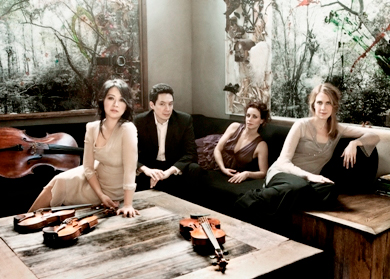by Daniel Hathaway

Since the Daedalus Quartet last performed on the CCMS series four years ago this month, half of its membership has changed. Violinist Kyu-Young Kim decamped for the St. Paul Chamber Orchestra, where he uniquely fills both the role of director of artistic planning and principal second violin, and cellist Raman Ramakrishnan has gone on to play with the Horszowski Trio. New players who have now joined founding violinist Mi-Young Kim and violist Jessica Thompson (who came onboard later) are second violinist Matilda Kaul and cellist Thomas Kraines.
That represents a big shift in personnel for a still-young quartet and some adjustments are probably still being made. That could explain the rather unsettled beginning and somewhat erratic ebbs and flows in Mendelssohn’s E-flat quartet, op. 12, which opened a program Kaul later told us could be titled “Early Works by Great Composers.” Written when Mendelssohn was 20, the piece is charming and predictive of interesting things to come. Some scrappy moments aside, the Daedalus turned in thrillingly energetic playing in the fast movements. When everything came together, the quartet produced a lean, lithe and attractive sound. Sliding between pitches in the first violin sounded expressive at first but became a habit as the program progressed.
Erwin Schulhoff’s Five Pieces, written when the composer was 29 and dedicated to Milhaud — who must have loved them — are cheeky caricatures of the Viennese waltz, the serenade, a Czech dance, a tango and a tarantella. The Daedalus put their engaging details — ghostly parallel chords, jazzy rhythms and cascading climaxes — across entertainingly.
After intermission, George Perle’s Molto Adagio, written when the composer was 23, amounted to a dozen minutes of slowly pulsating gestures.
In Britten’s first quartet, op. 25, the Daedalus finally got to show off their formidable individual and ensemble technique, with shimmering high passages in violins and viola against pizzicati in the cello, and striking solo outbursts from all players in turn. The piece, written in the U.S. when Britten was 28, is episodic and full of thematic playfulness, features that the Daedalus brought vividly to the foreground.
Continuing that theme of early works, the Daedalus gave us Haydn’s opus 1, no. 3 as a gentle and lyrical encore.
Published on ClevelandClassical.com December 10, 2013
Click here for a printable version of this article.



